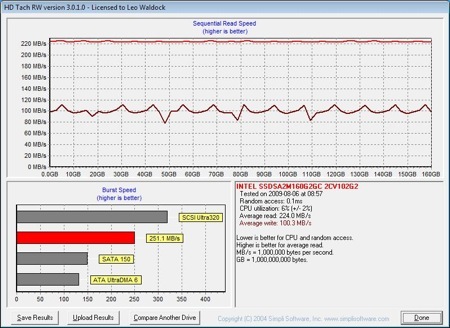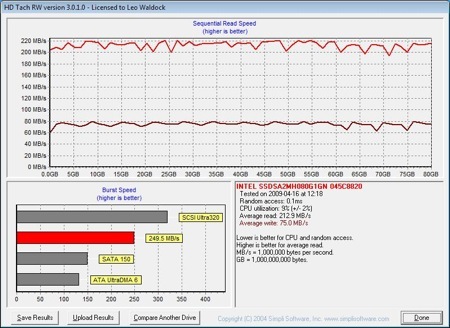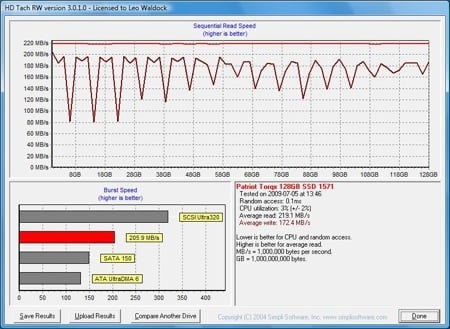Original URL: https://www.theregister.com/2009/08/18/review_storage_ssd_intel_x25_m_2nd_gen/
Intel X25-M 34nm Flash SSD
The chip giant's second-gen solid-state drive
Posted in Personal Tech, 18th August 2009 12:02 GMT
Review Intel was the first company to deliver a Sata SSD, its 80GB X25-M, and we were blown away by the combination of speed and silence. Unfortunately, the price was rather steep but you can’t make an omelette without breaking eggs.
When we reviewed the X25-M, it never occurred to us to ask about the fabrication process that Intel used to make the multi-layer cell (MLC) Flash memory chips. We were presented with that information when Intel launched the second-generation of X25-M drive. It turns out that the original process was 50nm and the new chips use a 34nm process.
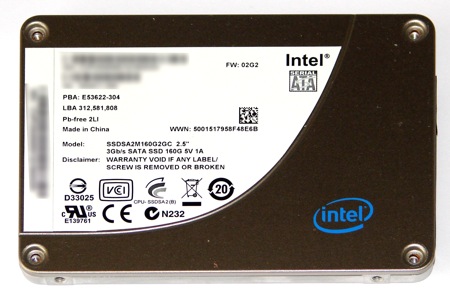
Intel's X-25M: slimmer, more capacious and cheaper
Inside the casing, the layout of the second-gen X25 looks similar to the first edition, but when you take a closer look you can see that all of the major components have been changed.
The single chip of cache memory has been increased in capacity from 16MB to 32MB, although the clock speed seems to have been reduced. The model code of the controller chip has been updated from PC29AS21AA0 to PC29AS21BA0, presumably to interface with the new Flash memory. The 1G drive used 20 chips to deliver the 80GB capacity, which works out to 4GB per chip.
With 2G SSD, the 80GB drive has ten 8GB chips on the same side of the PCB as the controller and cache with nothing on the back side of the board. The new layout suggests that a 160GB version should be a doddle and a 320GB drive would only require one spin of the memory technology.
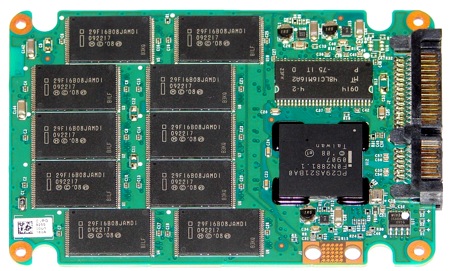
34nm Flash chippery
The difference in specification between 1G and 2G is surprisingly small despite the change from 50nm to 34nm technology. The headline figures for sustained sequential read and write speeds are unchanged at 250MB/s and 70MB/s, respectively. The latencies have dropped from 85µs read and 115µs write to 65µs and 85µs which doesn’t sound like it will be very significant.
Active power consumption remains unchanged at 150mW, while idle power consumption rises slightly, from 60mW to 75mW.
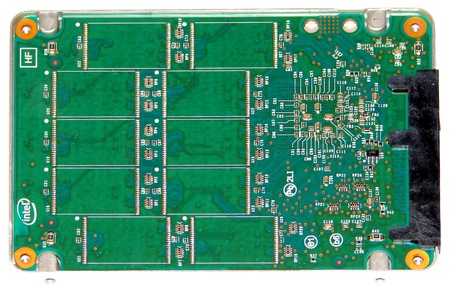
This time the back of the board is empty... how long before a 320GB drive appears?
The major change that results in the change in fabrication process is a reduction in production cost which, in turn, leads to lower retail prices. When Intel launched the 1G drives, the prices were $595/£399 for the 80GB model and $945/£799 for the 160GB version. When the competition started to pile into the SSD market with drives that used controllers from Indilinx, JMicron and Samsung, we saw Intel’s prices drop to $390/£207 and $765/£506, respectively.
The 2G drives are priced significantly lower: $225/£172 for the 80GB and $440/£334 for the 160GB.
You can't compare the price of Intel SSDs with the other manufacturers' offerings directly as the storage capacities differ. Intel offers 80GB and 160GB, while Samsung has 128GB and 256GB drives, and the memory companies round off the capacities to 120GB and 250GB.
If we look at the cost per gigabyte, the Intel drives started at £5 per GB which was reduced to £2.59 per GB and £3.16 per GB when the 1G drives had their price cuts. With 2G, those prices come down to £2.15 per GB (80GB) and £2.09 per GB (160GB) which is very similar to the competition and it puts the Intel, Indilinx and Samsung controllers on an even footing.
Externally, the 2G Intel drive has undergone a few changes. The casing has changed in colour from black to silver, and the drive has been slimmed down from 9mm to 6.5mm so it can fit in any laptop drive bay. Intel supplies a plastic spacer that can be attached to ensure the drive fits snugly in a larger bay.
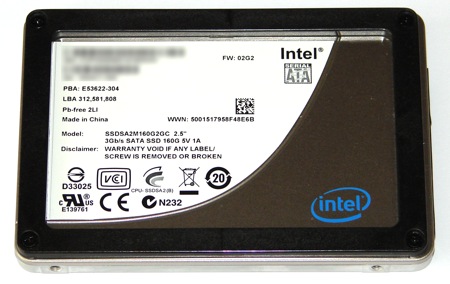
Intel includes a spacer for bigger drive bays
In the past, we've reviewed the 80GB X25-M and now with 2G we have finally got our hands on a 160GB drive with pre-release 2CV102G2 firmware. We tested the 2G alongside the 80GB X25-M and a 128GB Patriot Torqx which has an Indilinx controller. All three were fitted into a Core i7 system using 32-bit Windows Vista Ultimate Edition.
HDTach Readouts
34nm 2G X25-M
50nm 1G X25-M
Patroit Torqx
There's no doubt that the performance of the 2G drive has perked up compared to 1G. This is particularly clear when you look at the write performance in HDTach 3 and CrystalDiskMark 2.2 where it used to come in at 70-75MB/s. Write speed has perked up to 100MB/s which is a useful increase. However, it's still a long way shy of the Torqx, which clocks more than 170MB/s.
HDTach Results
Average Data Transfer Speeds
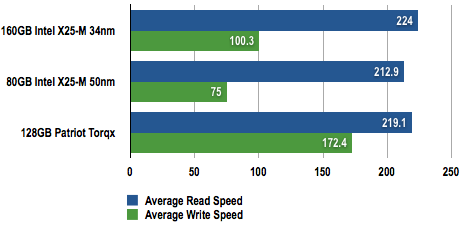
Data Throughput in Megabytes per Second (MB/s)
Longer bars are better
CrystalDiskMark 2.2 Results
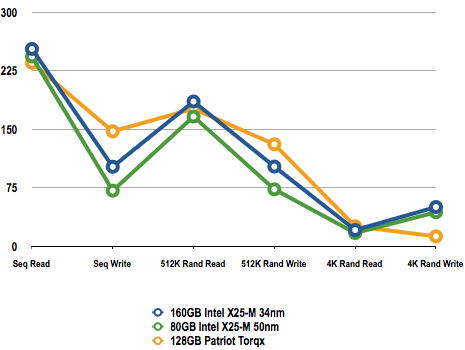
Data Throughput in Megabytes per Second (MB/s)
Higher points are better
Those synthetic benchmarks emphasise differences that you can see in real-world tests and in particular when you copy files on the drive. The 1G Intel does quite poorly in this type of file transfer test, but the 2G is much faster and is nearly on an equal footing with the Torqx.
The third group of tests involves the transfer of 2GB of files from one drive to another. When we moved files between the Torqx and the two Intel drives, it was clear that the 2G drive wins out over the 1G in all departments.
2GB File Transfer Results
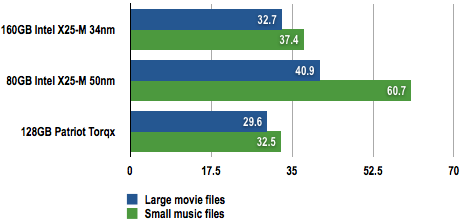
Transfer time in Seconds (s)
Shorter bars are better
So there we have it, the new Intel SSD is a triumph when it is compared to its predecessor. In terms of performance, it is beaten by the likes of the Patriot Torqx, but the low price of the new Intel drive makes it a better overall deal.
Price Matching
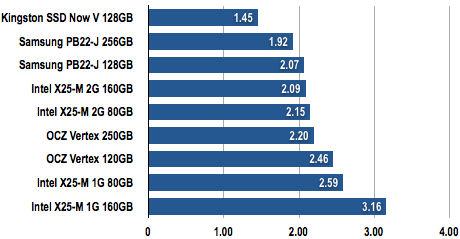
Price per Gigabyte
Shorter bars are better
That should be the end of the matter. However, Intel announced a worrying problem with the initial release of the new SSD. If you set a Bios protection password, then change or disable the password and then turn off the power, "the system may become inoperable".
We thought we’d try to replicate the issue. We created, changed and deleted Bios passwords with gay abandon and found absolutely nothing amiss. We wouldn’t suggest you ignore Intel’s warnings, but it seems to us that the issue isn’t as cut and dried as change password, lose data.
Fortunately, Intel has now posted a firmware fix, taking the drive's on-board software from 2CV102G2 to 2CV102G9. That, it says, is all you need to be safe.
Verdict
Intel’s 34nm Flash memory die-shrink has increased the performance of its revamped X25-M and at the same time made the SSD much cheaper. Excellent news. ®
More SSD Reviews...

Kingston SSD Now V |

Patriot Torqx |

OCZ Vertex |

Samsung PB22-J |
